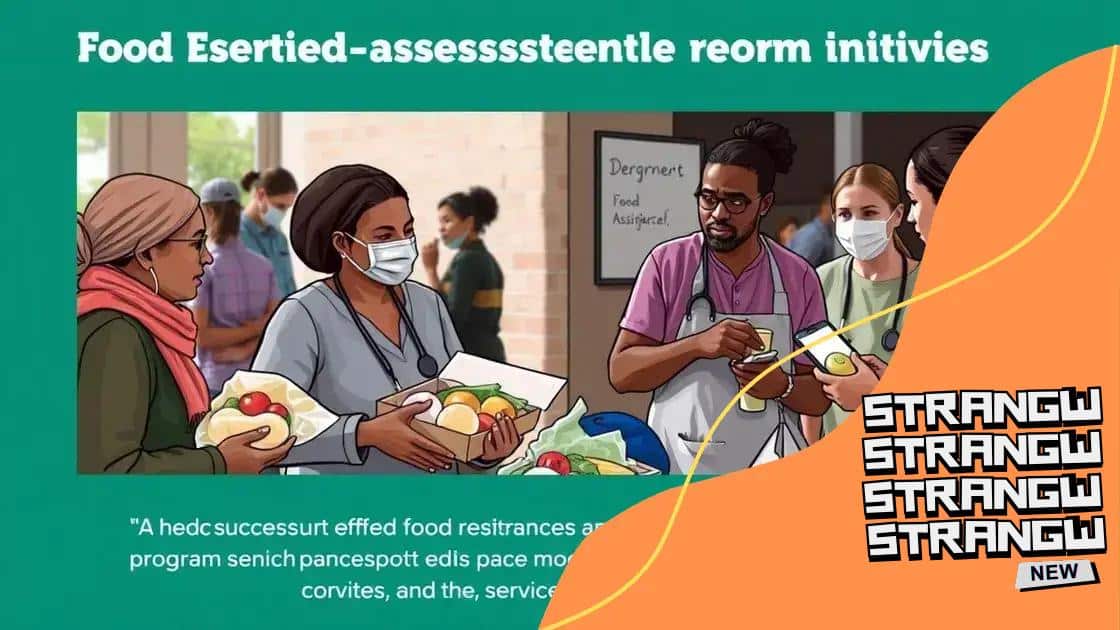Food assistance program reforms: What you need to know

Food assistance program reforms focus on improving access, sustainability, and leveraging technology to effectively support individuals and families facing food insecurity.
Food assistance program reforms have become a hot topic, impacting countless individuals and families striving for better nutritional support. Ever wondered how these changes affect your community?
Understanding food assistance programs
Understanding food assistance programs is essential for grasping how many communities support their vulnerable members. These programs play a crucial role in addressing food insecurity, ensuring that families have access to the nutrition they need.
Types of Food Assistance Programs
There are several types of food assistance programs available. Each program targets specific needs and populations. Some of the most common include:
- Supplemental Nutrition Assistance Program (SNAP)
- Women, Infants, and Children (WIC)
- Food Distribution Programs
- School Meal Programs
Each of these programs has unique benefits and eligibility requirements, helping a variety of individuals. For instance, SNAP provides financial assistance to low-income families, whereas WIC focuses on the nutritional needs of pregnant women and young children.
How Food Assistance Programs Work
Food assistance programs operate through various funding sources, including federal, state, and local governments. These programs often work alongside non-profit organizations to distribute food and resources effectively.
Many programs utilize an application process to determine eligibility. Once approved, individuals can access benefits ranging from food stamps to vouchers for purchasing groceries. Moreover, some programs provide direct food distribution, ensuring that no one goes hungry.
Challenges Faced by Food Assistance Programs
Despite their benefits, food assistance programs face numerous challenges. These obstacles can hamper their effectiveness. Common challenges include:
- Stigmatization of recipients
- Funding limitations
- Administrative complexity
- Rising food costs
Overcoming these challenges is vital for improving food security in communities. By addressing these issues, programs can better deliver resources to those in need.
Key challenges in food assistance reforms
The key challenges in food assistance reforms can significantly impact their effectiveness and reach in communities. These reforms aim to improve access to nutritional resources, but various obstacles can hinder progress and implementation.
Stigmatization of Recipients
One major challenge is the stigmatization of individuals who rely on food assistance. Many people feel embarrassed when seeking help, which can prevent them from accessing the resources they need. This stigma can discourage eligible families from applying for benefits.
Funding Limitations
Another significant challenge is inadequate funding for programs. Without proper financial support, food assistance programs struggle to provide sufficient resources. Limited budgets can lead to cuts in services, reducing the number of families that can receive aid.
- Reduced outreach efforts
- Longer processing times for applications
- Shortages in food supplies
- Lower quality of food offered
These issues can create a cycle of food insecurity that is difficult to break. Addressing funding limitations can help to expand services and reach more individuals in need.
Administrative Complexity
Administrative complexity poses another obstacle to effective reforms. Many food assistance programs have extensive paperwork and eligibility requirements. This process can be overwhelming for families who need immediate help.
Streamlining processes can make it easier for individuals to apply and receive support. Simplifying the application process can reduce barriers and increase participation in programs.
Rising Food Costs
Lastly, rising food costs impact food assistance reforms. As prices increase, more individuals and families struggle to afford nutritious food, further straining the resources of assistance programs.
As reforms progress, addressing these key challenges will be crucial for improving food security and ensuring that help reaches those who need it the most.
Successful case studies of reforms

Successful case studies of food assistance reforms highlight innovative strategies that improve access to food and support for those in need. These examples offer insights into effective practices that can be adopted by other programs.
Case Study 1: The Community Food Bank
A leading example is the Community Food Bank, which implemented a mobile pantry to reach areas with high food insecurity. This initiative brought essential supplies directly to neighborhoods, reducing access barriers for families facing difficulties.
- Increased participation by 40%
- Enhanced community engagement
- Utilized local volunteers
- Provided fresh produce and staples
As a result, the program saw significant improvements in the nutrition of families involved, illustrating how mobile solutions can effectively bridge gaps.
Case Study 2: The SNAP Outreach Program
Another noteworthy example is the SNAP Outreach Program, which focused on simplifying the application process for applicants. By offering assistance at community events and online resources, the program increased enrollment rates.
This approach led to:
- Streamlined processes with fewer forms
- Greater awareness of eligibility requirements
- Improved support from local agencies
- Higher retention rates of enrolled families
Such efforts demonstrate the importance of accessibility and outreach in promoting food assistance reforms.
Case Study 3: School Meal Innovations
Schools that adopted innovative meal programs also showed tremendous success. By revising meal offerings to include more healthy options and culturally relevant foods, schools met the needs of diverse student populations.
These changes resulted in:
- A notable increase in student participation in meal programs
- Positive feedback from parents and students
- Enhanced overall health among students
- Reduced food waste in schools
These case studies serve as models for effective food assistance reforms. They showcase how tailored solutions can meet the unique needs of communities.
The role of technology in food assistance
The role of technology in food assistance is increasingly important as it helps streamline processes and improve access for those in need. Various technological advancements play a significant part in enhancing food distribution and support systems.
Improving Access through Mobile Applications
Mobile applications are revolutionizing how families access food assistance. These apps allow users to find local food pantries and meal programs with just a few taps on their smartphones. They provide crucial information about eligibility and benefits.
- Real-time updates on available resources
- Navigation to nearest assistance sites
- Integration of application forms
- User-friendly interfaces for ease of use
As a result, mobile technology reduces barriers and encourages more families to utilize food assistance programs.
Data Management and Efficiency
Another significant contribution of technology is in data management. Food assistance programs can collect and analyze data to track the effectiveness of their services. This helps organizations understand community needs better and allocate resources accordingly.
With efficient data systems, programs can:
- Identify trends in food insecurity
- Adjust services to match community needs
- Enhance operational efficiency through analytics
- Monitor success rates of outreach initiatives
This use of data allows for a more responsive and targeted approach to tackling food insecurity.
Innovations in Food Distribution
Innovations in food distribution have also transformed food assistance. Technologies such as blockchain ensure transparency in food sourcing and delivery. By tracing the food supply chain, organizations can verify the quality and sustainability of food being distributed.
Moreover, advancements like automated inventory systems help maintain stock levels and reduce waste. These technologies ensure that food banks and assistance programs operate smoothly, allowing them to serve communities more effectively.
Overall, the integration of technology in food assistance is paving the way for more efficient, accessible, and effective support systems, ultimately helping to alleviate food insecurity.
Future trends in food assistance programs
Future trends in food assistance programs are shaping how support systems adapt to the changing needs of communities. These trends focus on improving access, enhancing sustainability, and leveraging technology for better outcomes.
Personalization of Services
One of the key trends is the personalization of food assistance services. Programs are beginning to tailor their offerings based on individual needs and preferences. This means understanding the unique circumstances of each family and providing customized solutions.
- Offering food choices that cater to cultural preferences
- Adjusting portion sizes based on family size
- Incorporating dietary restrictions and health needs
- Providing educational resources on healthy eating
These personalized approaches help families feel more empowered and supported in their food choices.
Sustainability Practices
Another significant trend is the emphasis on sustainability within food assistance programs. As communities become more aware of environmental issues, programs are adopting practices that promote sustainable food systems.
Some examples include:
- Partnering with local farms for fresh produce
- Reducing food waste through proper distribution methods
- Encouraging community gardens
- Utilizing eco-friendly packaging for food delivery
These initiatives not only address food insecurity but also contribute to a healthier planet.
Technological Advancements
Technological advancements will continue to play vital roles in the evolution of food assistance. Innovations such as artificial intelligence and data analytics can enhance efficiency and outreach efforts.
Programs that utilize technology can:
- Predict food needs based on data trends
- Improve communication with clients
- Track food inventory in real time
- Analyze program impact through metrics
By embracing technology, food assistance programs can respond more rapidly and effectively to the needs of their communities.
Incorporating these future trends can greatly enhance the effectiveness of food assistance programs, ensuring they meet the evolving needs of those they serve.
FAQ – Frequently Asked Questions about Food Assistance Programs
What are food assistance programs?
Food assistance programs are designed to provide support to individuals and families in need by offering access to nutritious food and resources.
How can technology improve food assistance programs?
Technology enhances food assistance by streamlining applications, improving data management, and facilitating better communication between services and clients.
What is the importance of sustainability in food assistance?
Sustainability in food assistance helps reduce waste and supports local food systems, ensuring that resources are used efficiently and responsibly.
How can communities get involved in food assistance efforts?
Communities can participate by volunteering at local food banks, organizing food drives, or supporting initiatives that promote food security.





